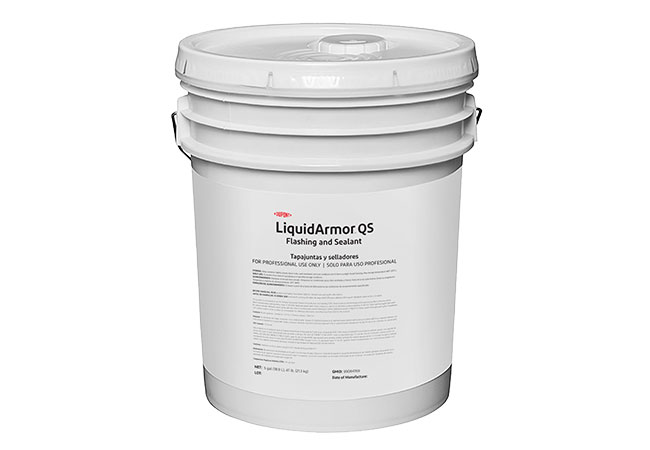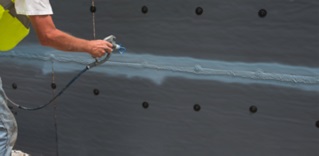DuPont™ LiquidArmor™ QS Flashing and Sealant
Advanced Liquid Flashing Alternative for Commercial Applications


DuPont™ LiquidArmor™ QS Flashing and Sealant
Advanced Liquid Flashing Alternative for Commercial Applications
<br><b>DuPont™ LiquidArmor™ QS Flashing and Sealant</b> is a quick skinning, innovative, liquid flashing solution designed to provide advanced moisture and air sealing protection to commercial buildings. A unique alternative to flashing tape, the elastomeric spray forms a tight, seamless barrier along the rough openings of windows and doors while helping to significantly reduce labor time.
<br><br>
<b>LiquidArmor™ QS</b> offers excellent sealing for the installation of the Thermax™ Wall System and or the Ultra Wall System. The liquid flashing solution covers and seals hard-to-reach gaps up to a quarter inch wide and offers a reliable replacement to peel and stick flashing tapes commonly used on board joints of commercial buildings. The versatile, water-based coating of <b>LiquidArmor™ QS</b> works on a wide range of surfaces, including foam boards, steel studs, concrete masonry units, tapes and wood buck. With sprayable, aqueous technology, it facilitates a consistent application using commonly available airless paint sprayers.
<br><br>
<b>LiquidArmor™ QS</b> seals around screws, veneer anchors and penetrating fasteners, resulting in a durable and resilient barrier suited to withstand job site variations and long-term building performance. Once the sealant sets to the final elastomeric solid, the treated area is protected and helps provide superior air leakage and moisture control as part of a joint treatment with DuPont’s commercial wall assemblies.
Features & Benefits
Specifications
Standard Sizes
| Unit | Unit Size | Units per Pallet |
|---|---|---|
| Pail | 5 Gallons* | 36 |
Note: *The 5-gallon pail of LiquidArmor™ QS Flashing and Sealant is packaged by weight, with a net weight of 47 lbs(21kg).
Testing
<b>LiquidArmor™ QS Flashing and Sealant</b> exhibits physical properties as indicated in the tables below when tested as represented. Review all instructions and (Material) Safety Data Sheet ((M)SDS) before use. Please contact DuPont at 1-833-338-7668 when additional guidance is required for writing specifications that include this product.
| TEST METHOD | TEST TITLE | PROPERTY | RESULTS |
|---|---|---|---|
| STRENGTH | |||
| ASTM D412 | Standard Test Methods for Vulcanized Rubber and Thermoplastic Elastomers—Tension | Tensile Strength | 190 psi |
| ASTM D412 | Standard Test Methods for Vulcanized Rubber and Thermoplastic Elastomers—Tension | Elongation at Break | 2.83 |
| WATER | |||
| ASTM E96 | Standard Test Methods for Gravimetric Determination of Water Vapor Transmission Rate of Materials | Water Vapor Transmission Method B | 4 perms @ 50 wet mils |
| GENERAL | |||
| AAMA 714 | Specification for Liquid Applied Flashing Used to Create a Water-Resistive Seal around Exterior Wall Openings in Buildings | Accelerated Weathering Section 5.3 | PASS |
| AAMA 714 | Specification for Liquid Applied Flashing Used to Create a Water-Resistive Seal around Exterior Wall Openings in Buildings | Elevated Temperature Section 5.4 | PASS |
| AAMA 714 | Specification for Liquid Applied Flashing Used to Create a Water-Resistive Seal around Exterior Wall Openings in Buildings | Crack Bridging Section 5.6 | PASS |
| ASTM D1970 | Standard Specification for Self-Adhering Polymer Modified Bituminous Sheet Materials Used as Steep Roofing Underlayment for Ice Dam Protection | Nail Sealing Ability | PASS |

